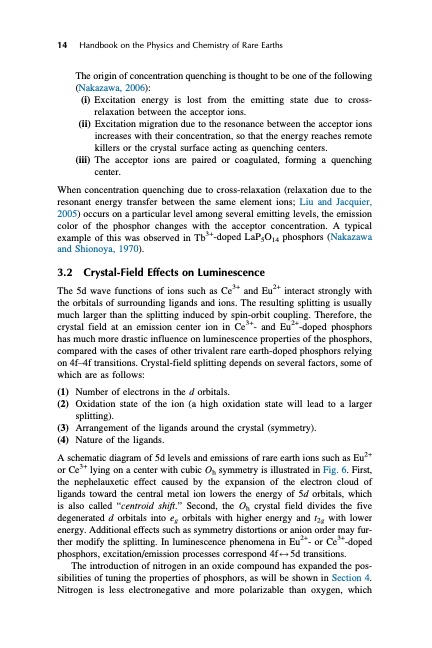
PDF Publication Title:
Text from PDF Page: 050
14 Handbook on the Physics and Chemistry of Rare Earths The origin of concentration quenching is thought to be one of the following (Nakazawa, 2006): (i) Excitation energy is lost from the emitting state due to cross- relaxation between the acceptor ions. (ii) Excitation migration due to the resonance between the acceptor ions increases with their concentration, so that the energy reaches remote killers or the crystal surface acting as quenching centers. (iii) The acceptor ions are paired or coagulated, forming a quenching center. When concentration quenching due to cross-relaxation (relaxation due to the resonant energy transfer between the same element ions; Liu and Jacquier, 2005) occurs on a particular level among several emitting levels, the emission color of the phosphor changes with the acceptor concentration. A typical example of this was observed in Tb3+-doped LaP5O14 phosphors (Nakazawa and Shionoya, 1970). 3.2 Crystal-Field Effects on Luminescence The 5d wave functions of ions such as Ce3+ and Eu2+ interact strongly with the orbitals of surrounding ligands and ions. The resulting splitting is usually much larger than the splitting induced by spin-orbit coupling. Therefore, the crystal field at an emission center ion in Ce3+- and Eu2+-doped phosphors has much more drastic influence on luminescence properties of the phosphors, compared with the cases of other trivalent rare earth-doped phosphors relying on 4f–4f transitions. Crystal-field splitting depends on several factors, some of which are as follows: (1) Number of electrons in the d orbitals. (2) Oxidation state of the ion (a high oxidation state will lead to a larger splitting). (3) Arrangement of the ligands around the crystal (symmetry). (4) Nature of the ligands. A schematic diagram of 5d levels and emissions of rare earth ions such as Eu2+ or Ce3+ lying on a center with cubic Oh symmetry is illustrated in Fig. 6. First, the nephelauxetic effect caused by the expansion of the electron cloud of ligands toward the central metal ion lowers the energy of 5d orbitals, which is also called “centroid shift.” Second, the Oh crystal field divides the five degenerated d orbitals into eg orbitals with higher energy and t2g with lower energy. Additional effects such as symmetry distortions or anion order may fur- ther modify the splitting. In luminescence phenomena in Eu2+- or Ce3+-doped phosphors, excitation/emission processes correspond 4f$5d transitions. The introduction of nitrogen in an oxide compound has expanded the pos- sibilities of tuning the properties of phosphors, as will be shown in Section 4. Nitrogen is less electronegative and more polarizable than oxygen, whichPDF Image | HANDBOOK ON THE PHYSICS AND CHEMISTRY OF RARE EARTHS

PDF Search Title:
HANDBOOK ON THE PHYSICS AND CHEMISTRY OF RARE EARTHSOriginal File Name Searched:
Chemistry-Rare-Earths-49.pdfDIY PDF Search: Google It | Yahoo | Bing
Sulfur Deposition on Carbon Nanofibers using Supercritical CO2 Sulfur Deposition on Carbon Nanofibers using Supercritical CO2. Gamma sulfur also known as mother of pearl sulfur and nacreous sulfur... More Info
CO2 Organic Rankine Cycle Experimenter Platform The supercritical CO2 phase change system is both a heat pump and organic rankine cycle which can be used for those purposes and as a supercritical extractor for advanced subcritical and supercritical extraction technology. Uses include producing nanoparticles, precious metal CO2 extraction, lithium battery recycling, and other applications... More Info
| CONTACT TEL: 608-238-6001 Email: greg@infinityturbine.com | RSS | AMP |